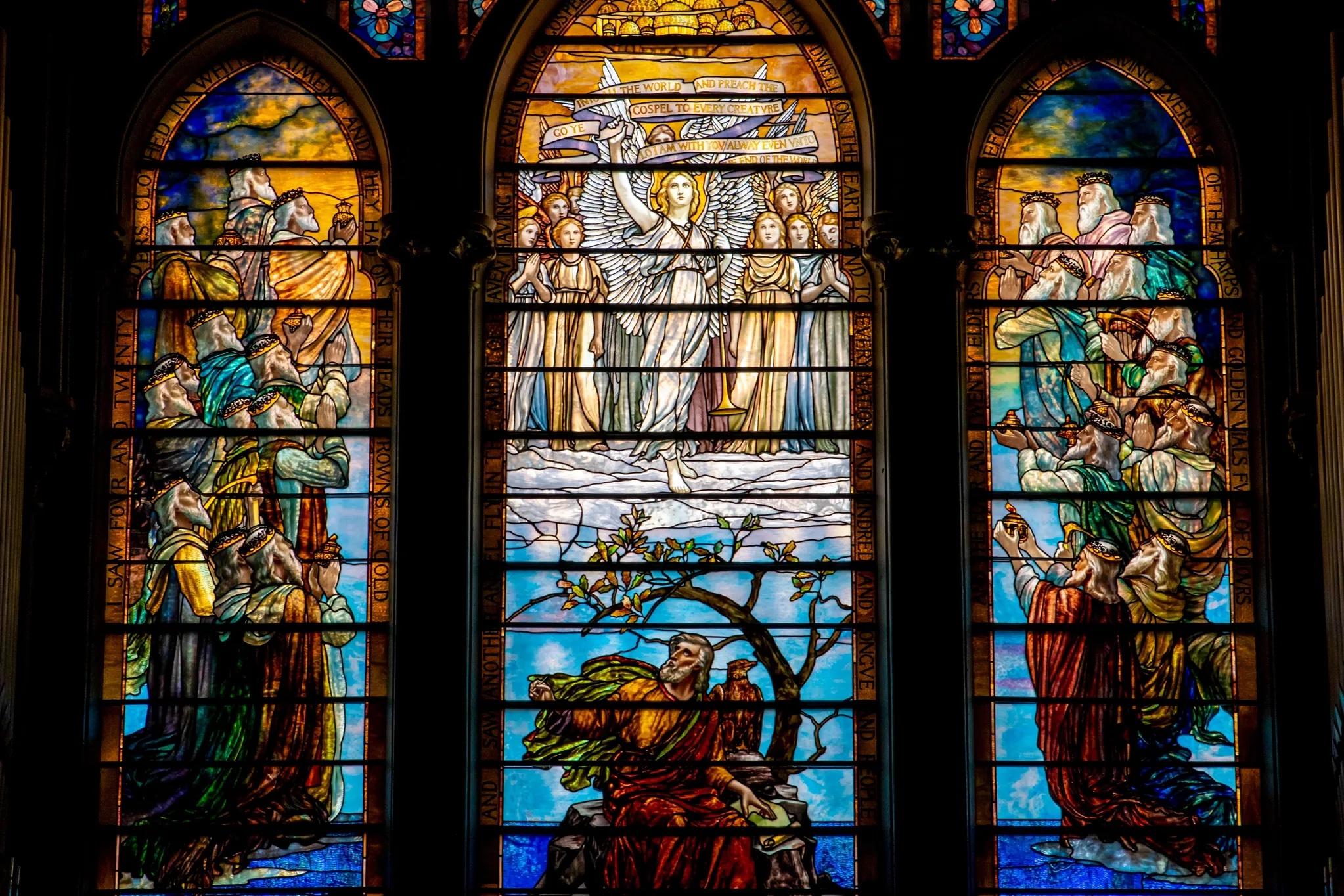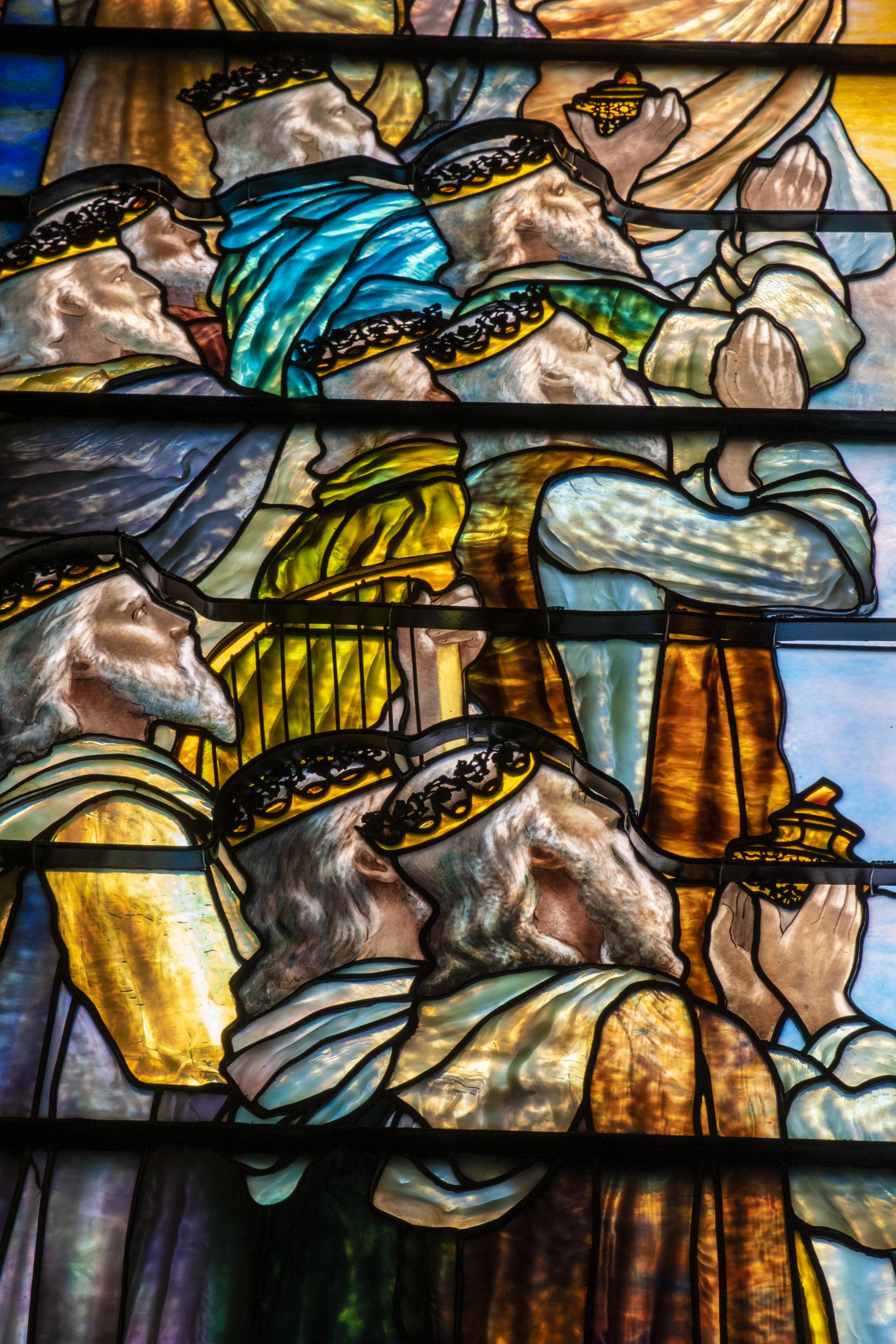THE APOCALYPSE WINDOW

The Tiffany window in the balcony at the back of the Sanctuary will be difficult to study while you are facing forward in the pews. However, at the conclusion of the morning worship service, it has become the custom of the congregation to turn around while, Brian Burns, our organist, plays the Postlude. This tradition began when Brian came to Calvary and began repairing our historic Ferrand & Votey organ. It seemed as though every Sunday we would hear some new sounds that we hadn't heard before! His skill in the restoration of this rare instrument has been as much of a blessing as his dedication as our organist and choir director.
The window depicts St. John on the Island of Patmos. This was not John, the apostle, but John the author of the book of Revelation who lived in the first century AD. He was exiled to this small barren island because he was a Christian living in Ephesus, had helped form a church there and the followers of Christ refused to acknowledge the divinity of the Roman Emperor, Domitian. This started the political persecution of Christians! It is also said that he was plunged into boiling oil in Rome, but suffered nothing from it! Naturally, everyone in the audience at the Colosseum immediately converted to Christianity after witnessing this miracle!
Patmos is one of the smallest islands in the south of the Aegean Sea. Originally, from a distance it looks like lumps of clay, and is only about 30 miles in circumference, mostly rocks! Men were banished there, and as convicts, faced a life of hard labor breaking up these rocks. (Today there is the beautiful monastery of St. John that's surrounded by white houses clinging together around it.)
It is estimated that John spent only about 18 months there and returned to Epheses after the death of Domitian. But in his suffering, he saw visions and prophesied that Rome would be punished and destroyed in an earthquake, but the Christians would be saved. In Rev. 21:2, he writes, "And I saw the holy city, new Jerusalem, coming down out of heaven from God..."
"He will dwell with them, and they shall be his people, and God himself will be with them; he will wipe away every tear from their eyes, and death shall be no more, neither shall there be mourning nor crying nor pain any more, for the former things have passed away." (Rev. 21:3,4)
Tiffany's depiction of this scripture begins at the top of the center lancet. There is a scene of a Biblical village bathed in golden light. Lower, on either side, robed and crowned figures are ascending into John's vision of the "New Jerusalem." Angels await. Is that Jesus in the center, depicted with his arm up, guiding and leading the elect, appearing as an angel himself?
John is below, on the small island with the barest of trees, in a particularly Art Nouveau style, so popular in the late 19th century! The shimmering sea surrounds him. The glass used to achieve this effect is Cathedral Glass so called because the process to create it results in a uniformly 1/8th inch think sheet. It is then pressed on one side with a horizontal ripple pattern. While the glass is still molten and soft, a large carved cherry wood cylinder is rolled over the sheet before the glass cools. Before the glass can be safely cut, it must be returned to the furnace on a lehr (a moving belt that carries the treated sheet of glass very slowly into the intense heat, and then back out to slowly cool it and "temper" it). As each color requires a different "melting point" this is a very tedious and expensive process. The color in all stained glass is created by throwing different powdered metals into the furnace of "clear" melted glass. Lead is used to clarify glass, yellow is made using selenium, green by adding copper, blue with cobalt, and manganese for some purples. Powdered gold is added to create ruby and pinks! Since Tiffany was always experimenting and mixing these various chemicals to produce more interesting shading, plus mixing those colors together as well as mixing them with milk (white) glass to create his "Opalescent" glass, there were many disasters! We have in our windows, only his triumphs, however!!
Since this large, triple lancet window faces to the west, the setting sun hits the glass in such a way that the water shimmers and sparkles! Heat waves rising from the slate roof enhance the visual effect. Some report the light is "almost blinding" at the Summer Solstice.
This beautiful window was presented to Calvary by the Varner family in memory of Bishop Matthew Simpson who married a daughter of this well-known Pittsburgh Merchant. Not only was Bishop Simpson a leader in the Methodist Episcopal Church, but he was a personal friend and confidant of President Abraham Lincoln! Letters between the two men reveal Lincoln's anxiety about sending so many young men to their deaths in the Great Civil War. His spiritual struggle to understand God's will was tenderly addressed by his friend. And Lincoln was consoled by Bishop Simpson's compassionate counsel. When Lincoln was assassinated, Bishop Simpson rushed to Washington, gave the eulogy at his funeral and rode the train with his friend's body to its final resting place.
That both Calvary and our sister church, First Church in Shadyside, were being built less than twenty years after the Civil War is a startling fact. It must be remembered that following the Civil War, America experienced a time of great invention, construction, and expansion! Large cities were being built; transportation was improving, and the telephone, electricity and elevators were fostering this positive growth. And there were no income taxes! Churches, colleges, museums and public buildings of every sort were being built for posterity, using the amazing skills of the immigrant workers who were very grateful to just get a job, and worked hard and long to prove their worth. We are truly blessed to have inherited their talent and dedication. With the significant contributions of the Allegheny Historic Preservation Society under the leadership of President, Tom Jackson, and currently Sandra Pack, these priceless windows have been saved! Organized in the late 1980's to specifically save this French Gothic masterpiece, generous donations and bequests from individuals, corporations and foundations have raised millions to accomplish this task! The original invoice from Tiffany Studios for the St. John window was $3,500. The restoration by Stained Glass Resources (see the excellent U Tube documentary and watch the tedious process from removal to completion!) under the leadership of Kirk Weaver now of Pittsburgh Stained Glass, was many times that! We are indebted and deeply grateful for all whose talent, sacrifice and vision contributed to our beautiful Calvary United Methodist Church building which continues to inspire us 125 years later!
Nancy Richards (Calvary UMC Member), April 27, 2019




